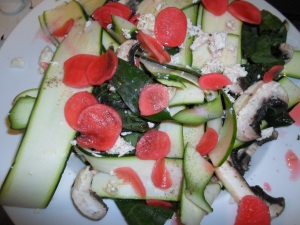Hi, my name is Dylan and I have a problem. I am addicted to preserving. I just can’t get enough of it; I dream about making jam all day long, I dry the skin of every citrus fruit I ever use and have an ever-growing list of chutneys and pastes that I’m dying to make.
Preserves are a great way of extending flavours to times well outside of their seasonality. Sometimes a rainy day can be brightened up a dollop of sugary strawberry jam; a stew can be taken to the next level with the addition of a few crisp fragments of citrus; the deep flavour bleeding into the sauce as it cooks throughout the day. On the flipside, pickled radishes; a delicious use of a winter vegetable are a great way to add a colourful crunch.
I have all of these great ideas, but I am running out of jars… and space in my pantry! I have promised myself that this one will be the last one for a while, so it’s a good thing that it’s such a stunner. Lemon, ginger and honey is just a comforting winter drink – good for the soul and good for the immune system, so I decided to see how it fared as a chutney combination.

I wanted something warming – if it’s going to be of any use in the winter then its warmth has to emanate throughout the body with each bite. Lemon, ginger and turmeric seemed like the ideal combination; it’s tangy, fragrant and warm, but not too spicy or overpowering, and not too sweet.

Here’s what you’ll need:
6 lemons
a decent size piece of fresh ginger
a handful of turmeric bulbs
a dash of vinegar
6 tablespoons of salt
1 teaspoon each of fennel and coriander seeds
the juice of 6 additional lemons
As you can probably tell, this recipe can easily be scaled up or down, depending on the size of your jars.
Begin by dicing the ginger and turmeric. I used three turmeric bulbs and grated them as finely as possible – biting into a big hunk of bright, bitter turmeric is a dreadful thought, something I really wanted to avoid. I julienned the ginger root with similar audacity, even though I am not crazy at the idea of a mouthful of ginger, it seems less unpleasant than the turmeric so I tried to keep the slices as thin as I could.

Gently heat them in a tablespoon of olive oil, with the fennel and coriander, use a relatively low heat. I added a tablespoon of water to lightly steam them – I wanted to avoid crisping them up in any way possible. It might even work better to steam them over hot water first. Take the pan off the heat and toss through another dash of olive oil and a few caps of vinegar. I used apple cider vinegar for tartness and because it’s the only kind I had.
While that pan is filling your kitchen of smells reminiscent of an Arabian marketplace, it’s time to move on to the lemons. As most people on the internet will tell you; organic is best and freshly washed is also good. If you can help it, only pick your lemons once they are ripe, that way they will be juiciest as they stop ripening as soon as they are picked. The recipe that I based mine on (from Ottolenghi, duh) says to quarter them lengthways (but not quite to the bottom). For practicality, I diced mine into bite sized pieces; I thought this would make them easier to squeeze into the jar and easier to spoon out afterwards. Stir through the ginger and turmeric, the salt, and any herbs you think would suit; I used rosemary and a sprinkle of dried thyme.
Jam as much of the mixture into each jar as possible, it can be quite a messy job but try and keep the juice off the table and floor as much as possible! Seal the jars and leave in a cool, dark cupboard for a week.

Side note: make sure your jars are sterile you could end up with a fungus forest instead.
If patience is not a virtue you are the beholder of, then this is probably not something you should be experimenting with as this is merely the beginning. After a week, squish the lemons down and pour the juice of the six remaining lemons overtop, that should almost take your jar to capacity, add water to make up the difference and add another little glug of oil. Reseal and leave in the cupboard for at least four weeks to ferment.
Wait.
The fibres within the lemon rind will slowly break down, absorbing its own juice and the flavours of the ginger; sweet, tangy and soft.

Serve atop warm couscous, stir-fry with vegetables or any other kind of cooking. I added a few tablespoons to some sautéed mushrooms for a lemon and mushroom risotto and loved the tang it gave in contrast of the sweet chicken broth.











































